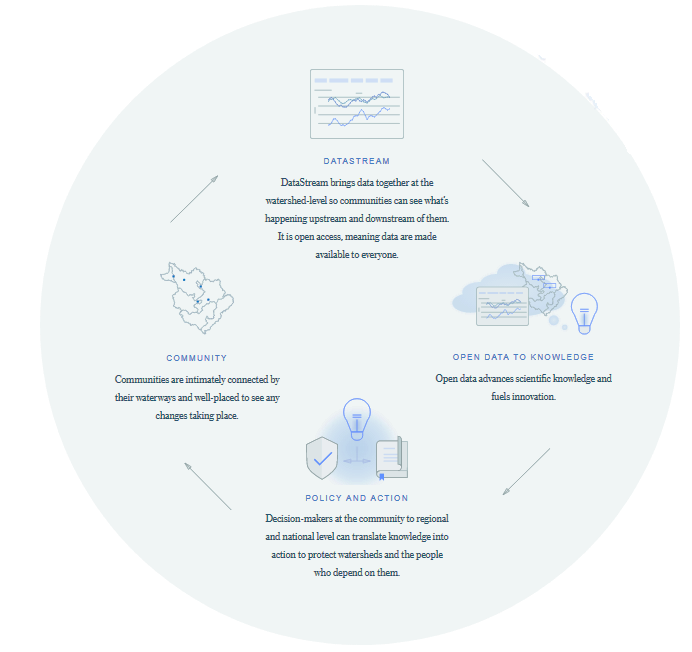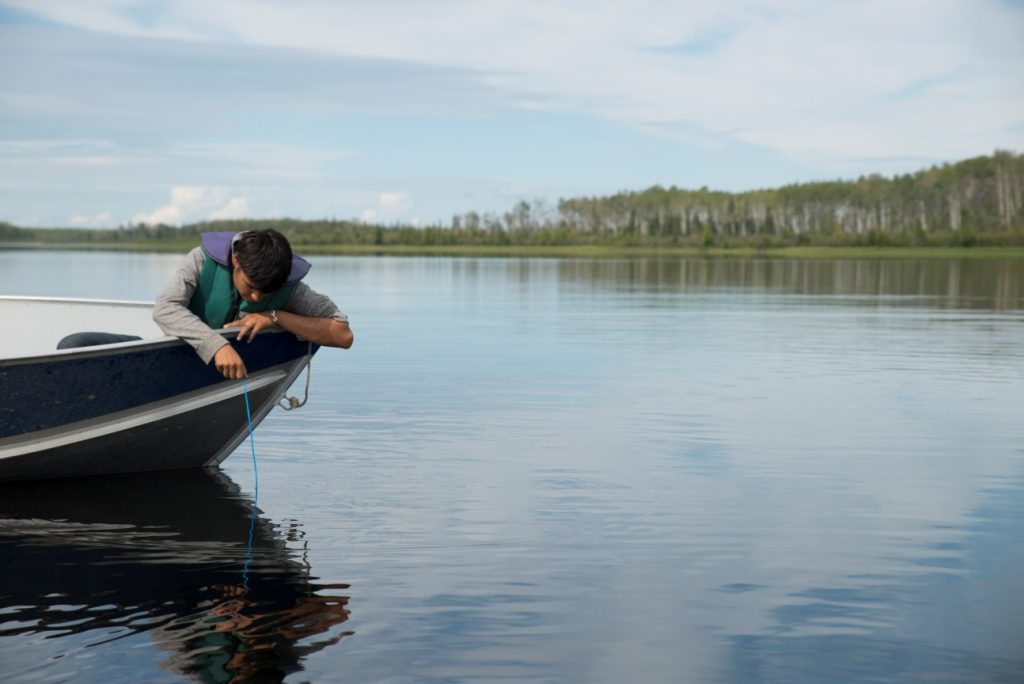Concerns about the future – Communities protecting basins with data and information
The Mackenzie River Basin represents a very important source for water resources for communities in the Northwest Territories, Canada. The Mackenzie River and its tributaries form the largest river basin in Canada. People in the basin extract and discharge water for a variety of uses; land and water use changes, impacts from industry, and climate change contribute to concerns over water quality. Communities from the Northwest Territories are concerned about the future of the Mackenzie River Basin and are looking for solutions and ways to protect the quality of water resources in the basin.
The Mackenzie DataStream supports water quality monitoring in the basin by housing data inputs collected by communities throughout the Mackenzie River Basin. The data and information that is uploaded to the DataStream aims to inform and educate about the quality of water resources and threats to these resources within the basin. Thanks to all the partners and data contributors, communities in the Northwest Territories, Northern British Columbia and Alberta, are increasing efforts to protect the future of the Mackenzie River Basin. The lessons from the Mackenzie DataStream could potentially be applied in other basins with a variety of stakeholders including those in urban areas.
1. The Problem
The Mackenzie River Basin is located in Canada, flowing 4,241 km from the Columbia Ice-field in Jasper National Park to its mouth at the Beaufort Sea in the Arctic Ocean. The basin covers nearly 20% of Canada and has six sub-basins: the Athabasca, the Peace, the Liard, the Peel, the Great Slave and the Mackenzie – Great Bear[1]. The basin has a population of about 400,000 people living primarily in remote, Indigenous communities, mainly accessible by air or water. The Mackenzie River Basin sustains not only communities, but also ecosystems that contribute to the Arctic Ocean circulation[2].
The Mackenzie River Basin is impacted by a number of stressors including climate change as well as land cover changes and pollution from industrial development. Rapid global climate change and urban development is affecting the water quality and ecosystem health at the basin level. Communities that rely on its water seek protection for these water resources. To protect and make sustainable decisions for freshwater management in the basin, it is necessary to have data; however, to date, there are limited applications and services to bring together and share data in an accessible ways. There are challenges for scientific communities and public surrounding the sharing of information, and this needs to change if communities want to protect the basin.
2. The Solution
Mackenzie DataStream was officially launched in November 2016 in the Northwest Territories and Ottawa. Mackenzie DataStream was built by the Gordon Foundation in partnership with the Government of the Northwest Territories and communities living in the Basin. The software was built by Tesera Systems Inc. DataStream is an open access application that contains high quality data and allows users to explore and share water data relevant to the Mackenzie River Basin. DataStream offers accurate and up-to-date information collected from 23 communities that monitor more than 50 sites and measure more than 70 parameters including, for example, temperature, PH, and turbidity. The Government of the Northwest Territories facilitates community-based monitoring within its territory and works with communities to ensure that the data are scientifically robust[3].
The goal
Mackenzie Data Stream aims to support Indigenous communities to keep track of water quality issues to reduce further damage in the basin.
The aim of this application is to provide freely available and accurate information that allows users, communities and scientific groups to actively be involved in protecting the water resources of the basin. Through Mackenzie DataStream, users and communities are empowered to share and collect open data and information about water quality. DataStream supports the engagement of users and communities in decision-making processes that shape policies for the sustainable management of the basin.
2.1. Mackenzie DataStream: Data-to-Policy Life Cycle
Mackenzie DataStream is an intuitive tool that is openly accessible and free of charge. To access it, users can visit the application website, enter a location, and specify the type of data needed.
The DataStream model follows a cyclical process that allows the hub to successfully function by providing and receiving information from scientists and communities within the basin:
- Mackenzie DataStream Platform: Collects and houses information at the basin level and shares it with communities
- Open data to knowledge: Access to open data allows scientific groups and communities to take action and provide innovative ideas for the protection of the basin
- Policy and action: Decision-makers, stakeholders, utilities and governments at the basin and national level use the information to take action and protect the basin
- Community: Users and people at the basin level are connected and understand the changes and threats to the basin. They take action, seek protection, and are involved in decision-making for the Mackenzie River Basin.
2.2. Tools
DataStream’s design is based on past experiences and applications created by Tesera Systems Inc. together with inputs from end-users and partners. Tesera is a group of developers, designers and data scientists focused on creating data-based web applications. Their applications involve the creation of tools used to prevent avalanches, track fires, monitor water quality and more[4].
Mackenzie DataStream benefited from lessons that Tesera learned from previous projects. To create Mackenzie DataStream and make it user friendly it was necessary to combine different programs. To ensure that the platform functions smoothly and without errors, Tesera made use of “Frictionless data”; a system created by Open-Knowledge International[5]. This system allows users to work around information and data (upload and download) without friction, making the process more dynamic and productive.
2.3. Participants
To ensure the successful implementation of DataStream, its continued usage and application requires the collaboration of different organisations and scientific groups. Each organisation has a role in successfully achieving collective goals for DataStream.
• The Gordon Foundation: A charitable organisation dedicated to protecting Canada’s water and amplifying underrepresented voices. The Gordon Foundation seeks to develop Mackenzie DataStream to provide tools and information for communities to protect their water resources and allows communities to influence the policies and decisions at the basin level[6].
• The Government of the Northwest Territories (GNWT): A key partner during the development and implementation of Mackenzie DataStream. The GNWT supports community-based monitoring activities and supervises the uploading of data in their region. Furthermore, they carry out research and provide information about environmental impacts and aquatic health. They do not only promote and share data but also help communities understand the data in order to take actions for the preservation of the water quality.
• Tesera Systems Inc.: Developer supporting The Gordon Foundation and the Government of the Northwest Territories in the creation of an application for environmental protection and water quality conservation in the Mackenzie River Basin. Tesera applies technology to support improved water quality assessment through open source applications[7].
• Fort Nelson First Nation (FNFN): Develops and implements land and water governance programmes in and for their community. Fort Nelson First Nation also provides support around strategic policy development, community consultation, and research projects inside their community. FNFN was the first community, outside of the NWT, to upload their data on Mackenzie DataStream. The partnership with FNFN has been important in the ongoing development of Mackenzie DataStream.
• Community: Partner communities who are actively monitoring the Basin’s waters play an essential role in Mackenzie DataStream by contributing massive amounts of data that is used to understand the quality and health of the freshwater bodies in the Mackenzie River Basin.[8].
Collecting data in the Mackenzie River Basin (Source: Pat Kane, 2017)
3. Outcomes
3.1. The challenges
For the DataStream platform, there were and still are many challenges to overcome.
Data is not open: Sharing information and data inside scientific communities can be challenging. Many researchers and organizations are not prepared to share information as a free/open source. This approach of sharing information is still a new concept inside the scientific world, but could contribute greatly to communities and watershed management.
The Gordon Foundation points to the difficulties of working with data; finding the right people and the right data is a challenge. The Government of the Northwest Territories provides support identifying the right group of scientific partners who work actively with communities to provide robust data.
Structuring Data: Organising and creating a data structure is the first step to establishing a library of information. Nevertheless, maintaining and following a structure requires educating users and collaborators; doing this can be cumbersome and requires additional resources and effort.
3.2. Improvements, what is next?
Mackenzie DataStream provides large amounts of monitoring information collected from various sampling points allowing users and communities to prepare reports and use the information to create protection plans and avoid the degradation of water resources in the Basin. Nevertheless, DataStream is still under development, and as the project continues to grow in scope and scale, new challenges and opportunities are encountered.
The Gordon Foundation is always looking for opportunities to improve DataStream. One of the most important improvements is the introduction of a systematic and standardised way to control the quality of uploaded data; together with this improvement, updating the interface of DataStream is on track.
Mackenzie DataStream seeks to present data in ways that can be easily understood by community users who may not have technical knowledge or a scientific background. All partners see the importance of accessibility, ensuring that the application reaches all knowledge levels so that every community member understands what is happening in the basin and empower them to take action and contribute to positive change. Therefore, improvements will target community inclusivity and data sharing.
3.3. The success of Mackenzie DataStream
There are plenty of tools and applications providing information about water-related parameters. However, there are few applications that provide access to data free of charge and allow users to monitor and upload information to be shared. This element of Mackenzie DataStream has greatly contributed to its success in northern Canada, as the tool addresses a significant knowledge gap. Thanks to DataStream, communities can track water quality issues and use this information to inform policy and decision-making for a healthy watershed. .
Mackenzie DataStream provides an instrument for communities to educate people about what is happening in the watershed and helps them take action to support sustainable management of water resources in the Mackenzie River Basin. DataStream provides a valuable tool for amplifying the impacts of community water monitoring, and supports knowledge sharing and evidence-informed decision-making.
Useful Links
Mackenzie DataStream. 2017. About DataStream. Available at: http://mackenziedatastream.ca/#/page/about-us
The Gordon Foundation. 2017. Mackenzie DataStream. Available at: http://gordonfoundation.ca/initiatives/mackenzie-data-stream/
The Gordon Foundation. 2017. Who we are. Available at: http://gordonfoundation.ca/
Tesera. 2017. Mackenzie DataStream. Available at: https://tesera.com/mackenzie-datastream/
Tesera. 2017. Available at: https://tesera.com/#welcome1
Key Words
| Canada | Northwest | Information tools | Policies |
| Community | Planning | Water quality | Law |
| Data and Information | Open Access | Free | Available |
| Freely available |
Cover Photo: Adam Jones, Ph.D. (Own work) [CC BY-SA 3.0 (https://creativecommons.org/licenses/by-sa/3.0)], via Wikimedia Commons
[1] http://www.mrbb.ca/information/9/index.html
[2] http://gordonfoundation.ca/initiatives/mackenzie-data-stream/
[3] https://tesera.com/mackenzie-datastream/
[4] https://tesera.com/
[5] http://frictionlessdata.io/about/
[6] http://gordonfoundation.ca/
[7] https://tesera.com/mackenzie-datastream/
[8] http://mackenziedatastream.ca/#/page/about-communities




